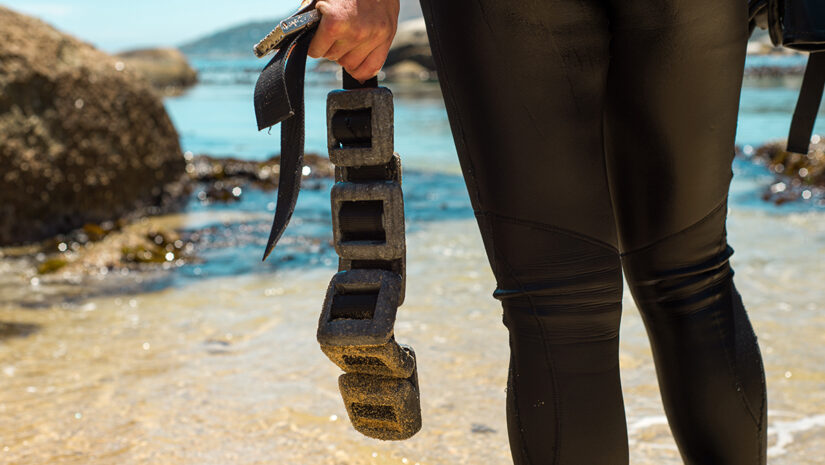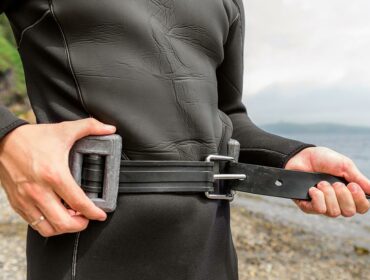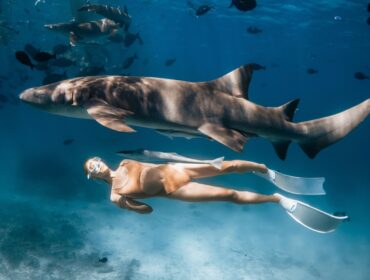Choosing the right weight system in scuba diving is essential for achieving proper buoyancy, safety, and overall comfort underwater. Selecting the correct weight system will help you maintain control during your dives, conserve energy, and enjoy your bottom time. This is true whether you’re a new diver or someone with more experience. With so many options available, it can be challenging to determine which weight system works best for you. We will guide you through the different types of weight systems. Including how to figure out the right amount of weight to use. Additionally, we will discuss why being properly weighted is crucial for enjoyable diving.
Types of Weight Systems
Weight Belt
Weight belts are a commonly used method to wear weights. They are typically worn around the waist. Hard lead weights are threaded onto the belt. The belt is easily adjustable, and quick-release buckles allow for fast removal in emergencies. You may choose a weight belt for your weight system because of its simplicity, affordability, and ease of customization, allowing weights to be shifted or added as needed. However, some divers find the pressure on the hips or lower back uncomfortable, especially during longer dives.
Integrated Weights
Many modern buoyancy control devices (BCDs) come with integrated weight pockets, allowing the weights to be placed inside the jacket itself. This weight system is convenient because it keeps the diver’s weight evenly distributed across the body, reducing strain on the lower back. Integrated weights can also be quickly released in an emergency by pulling handles attached to the weight pockets. Divers who value comfort and ease of setup often prefer integrated weights, although they can be slightly more expensive than a weight belt.

Hard Weights
Hard lead weights are the traditional choice for divers and can be used with either weight belts or integrated pockets. They are durable and long-lasting but may be less comfortable against the body than soft weights. You might choose hard weights for their durability and precision, but be sure that their setup doesn’t cause discomfort during longer dives.
Soft Weights
Soft weights are small pouches filled with lead shot or pellets. These weights conform more comfortably to the diver’s body, making them a popular choice for those who find hard weights uncomfortable. They are used with weight belts or integrated pockets and are equally easy to quick-release. Divers who prioritize comfort and flexibility often prefer soft weights.
Trim Weights
Trim weights are small, strategically placed weights that help divers achieve better body positioning and trim underwater. These can be placed in various areas, such as higher up on the BCD or near the tank. Trim weights are especially useful for experienced divers looking to fine-tune their buoyancy and reduce drag. They may not need to be quick-released, as they are usually smaller and positioned to help balance the diver’s buoyancy.
Ankle Weights
Ankle weights are small weights to help divers who experience difficulty keeping their legs down, especially when wearing buoyant wetsuits. While they are not commonly used by all divers, those with specific trim issues or those diving in thick exposure suits might find ankle weights useful. They provide a targeted solution to balance leg buoyancy but must be used carefully to avoid excessive drag.
How to Figure Out the Amount of Weight You Need
Step-by-Step Weight Check
A proper weight check ensures you have the right amount of weight for neutral buoyancy. Here’s how to perform a weight check:
- Float at eye level: At the surface of the water, while holding a normal breath and with your regulator in your mouth, you should float at eye level. If you sink too much, you’re overweighted; if you float too high, you’re underweighted.
- Exhale gently: As you exhale, you should slowly begin to sink. If you drop too quickly, you may have too much weight; if you barely sink, you may need to add more.
- Adjust as necessary: If you’re not able to achieve this neutral buoyancy, make small adjustments to your weights (either by adding or removing them) until you’re able to hover at eye level comfortably.
Rule of Thumb
For divers just starting, a rough guideline for calculating weight is 10% of your body weight. However, this is only a starting point and must be adjusted based on factors like exposure suit thickness, saltwater vs. freshwater, and tank type.
For example:
- Saltwater vs. Freshwater: You’ll need more weight for saltwater diving due to the increased buoyancy from salt content. Typically, divers will add around 2-6 pounds (1-3 kg) when transitioning from freshwater to saltwater.
- Body Weight Changes: Weight gain or loss can affect your buoyancy. Regular weight checks should be performed to account for these changes.
- Steel vs. Aluminum Tanks: Steel tanks are less buoyant than aluminum, meaning divers using steel tanks may require less additional weight compared to those using aluminum tanks.
Why it’s important to be weighted properly when scuba diving
Being correctly weighted for scuba diving is crucial for safety, buoyancy control, and overall comfort. When you’re properly weighted, you can maintain neutral buoyancy, allowing you to move effortlessly through the water without constantly adjusting your buoyancy control device (BCD). If you’re underweighted, you may struggle to descend and stay at depth, which can lead to exhaustion and increased air consumption. On the other hand, being overweighted makes it harder to ascend smoothly and can result in poor body position, dragging you down, and increasing the risk of injury. Proper weighting ensures a more enjoyable, efficient, and safe diving experience.
Whether you opt for a weight belt, integrated weights, or other options, understanding how to distribute and manage your weights effectively will enhance your diving experience. We hope you now have all the information you need to choose the right weight system for you!






